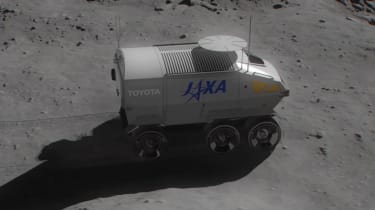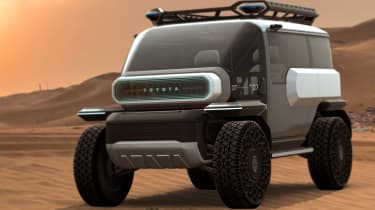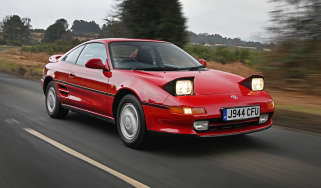Toyotas in space! Lunar Cruiser and Baby Lunar Cruiser moon buggies prepare for launch
The full-size Toyota Lunar Cruiser is on target for 2029 launch while a CALTY-designed Baby Lunar Cruiser has also been revealed
Not content on topping the global sales charts here on earth, Toyota’s now looking to the stars with projects focusing on the design and development of off-world rovers. There are two currently being undertaken, the main project focusing on the creation of a manned lunar rover for the Artemis space missions. Toyota’s Californian CALTY design studio is also getting involved with its own ‘baby’ rover, which at this stage is purely a design ideation project.
Officially called ‘Toyota Lunar Exploration Mobility Works Project’, the program was initially announced in 2019 and is being completed in conjunction with the Japanese space agency JAXA and NASA. In late 2022, a further collaboration with Mitsubishi Heavy Industries was also announced, and after three-years of joint research preliminary development is due to start next year. The project has a target launch date of 2029, when it will potentially be used by NASA for its Artemis missions, taking astronauts back to the moon for the first time since the Apollo 17 mission in 1972.
The vehicle itself, colloquially called the ‘Lunar Cruiser’, will be a pressurised rover capable of being operated without the need to wear a space suit. The cabin module would need to withstand far tougher conditions than anywhere on earth, as not only does it need to maintain pressure in the vacuum of the Moon’s almost non-existent atmosphere, but also the need to survive huge temperature changes from 120 degrees in the daytime to minus 130 degrees at night at the moon’s equator.
Temperatures are even more extreme at the poles, where lots of contemporary moon-based research is being conducted due to the possibility of surface or subsurface water ice, critical for future lunar and Mars exploration missions.
With preliminary development due to commence next year, Toyota and its partners have already established proposed dimensions of the six-wheeled craft at 6m long, 5.2m wide and 3.8m tall. This would allow for a proposed cabin volume of around 7m squared, in essence becoming a mobile living space and laboratory for astronauts.
Fumiya Tsutsui, Director for Space Exploration, JAXA Space Exploration Center (JSEC), Japan Aerospace Exploration Agency (JAXA) explained: “This crewed pressurised rover offers both mobility and habitability, enabling astronauts to move around and explore the moon’s surface for prolonged periods beyond the confines of the landing site. In a sense, it is a spaceship that drives on the moon.”
Development of the Lunar Cruiser will focus on four key technologies including regenerative fuel-cells, off-road driving performance, automated off-road driving capability and user-interface. The most complex of these is the fuel-cell powertrain, as rather than using a battery-electric propulsion system, Toyota will instead use its expertise in hydrogen fuel-cell technology for use in the Lunar Cruiser. Using a process called electrolysis, hydrogen extracted from liquid water (itself created from lunar ice, like that potentially located at the poles) can then be turned into electricity and form a near endless supply of energy for the rover and its occupants.
Ken Yamashita, Project Head of the Lunar Exploration Mobility Works Project, Toyota Motor Corporation said on the relevance to this project for its customers: “In pursuing this project, we want to contribute to Japan by advancing technology and enabling people to grow.
Even before the lunar landing in 2029, we hope to feed the technologies honed through the rover project back into society here on Earth.”
Other space projects from the automotive industry
Toyota CALTY Baby Lunar Cruiser
Alongside the main Toyota Lunar Cruiser project, California’s CALTY design studio has been hard at work designing the Baby Lunar Cruiser (BLC), a project that’s very much just a design concept. Designed in celebration of CALTY’s 50 year anniversary, the studio has been responsible for many of Toyota’s global models, from the original 1978 Celica right through to the modern day Tacoma pick-up.
Hyundai
Hyundai Motor Company has begun its own initial research project in conjunction with major Korean research institutes in the development of off-world rovers, both manned and unmanned. Initial test vehicles are due to be completed in the second half of 2024, and will focus on battery electric technologies and autonomous driving functions.
Nissan
Nissan has collaborated with JAXA in the development of its electric powertrains using its e-4OURS system as found in the Ariya SUV. Through the use of clever electronics and a system to independently control drive to each wheel, Nissan’s efforts will probably trickle down into its future EV projects, including a potential all-electric reboot of the GT-R.
Audi
Audi has completed its own Lunar project with its Lunar Quattro, a small unmanned rover that was designed for the Google Lunar XPRIZE competition. More of a concept at this stage, Audi collaborated with Part-Time Scientists for the project, a group of German engineers.
GM
General Motors has history with moon exploration as its engineers designed the original lunar rover used in the Apollo space program in the early 1970’s. More recently a partnership with Lockheed Martin produced a modern day prototype with the potential to take astronauts to the Moon’s south pole.
Want the latest car news in your inbox? Sign up to the free Auto Express email newsletter...
Find a car with the experts










